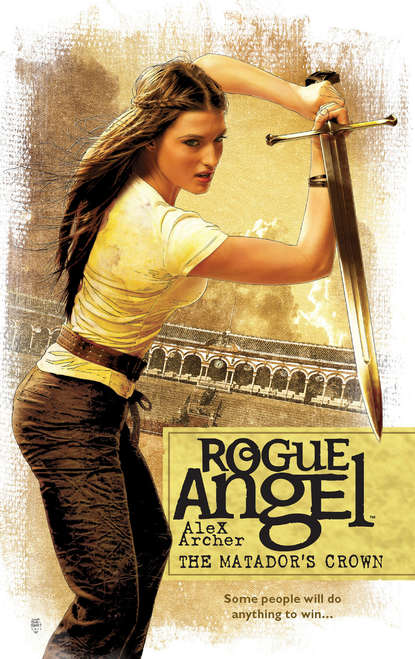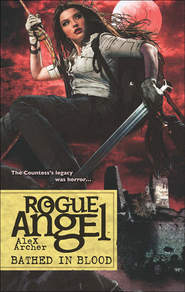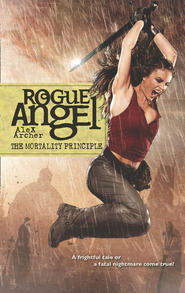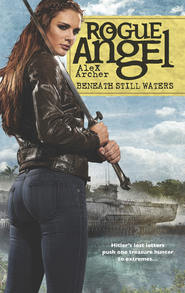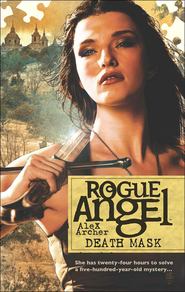По всем вопросам обращайтесь на: info@litportal.ru
(©) 2003-2024.
✖
The Matador's Crown
Автор
Год написания книги
2019
Настройки чтения
Размер шрифта
Высота строк
Поля
A beam of sun glinted in her eye, magnified by the silver waves ridging the sea to her left. The water was clear and the sand on the beach bright and clean-
looking. After a few hours at the museum, she intended to walk down to the shore. A perfect way to end the trip before her flight back home.
Much as she enjoyed travel, she was looking forward to returning to her apartment in Brooklyn and stealing some writing time. Annja had collected notes from digs in Austria and Turkey and wanted to translate them onto the computer and see if she could wrangle a worthy story in the mix. She loved writing, and had published a few books on archaeology, but found writing time spare because, more than pounding away at the keyboard, she loved actual digs, searching for new discoveries. Generally being outdoors. Adventure ran through her veins.
The Hotel Blanca’s white-tiled lobby was filled with potted palm trees, and the overhead latticework created crisscross patterns of sunlight. The elderly receptionist wore a severely tight bun of salt-and-pepper hair and gave Annja a rote welcome to the beautiful city of Cádiz. She looked Annja up and down—taking in the hiking boots sorely in need of new laces, her khaki cargo pants sorely in need of an iron and her T-shirt that featured a fading Women for Women logo—then took her credit-card information and handed her a key.
Annja thanked the receptionist and took the concrete stairs featuring brightly colored paintings along the risers two at a time. Not authentic Spanish design, but the entire city couldn’t be authentic, she figured.
She had always been curious about Spanish culture and artifacts—okay, artifacts from any culture and time period. She’d spent two summers interning on digs in Granada during her college years and had fallen in love with this country. The Andalusians were proud of their history, which began with the Phoenicians, and over the centuries incorporated influences from the Visigoths to the Islamic empire. They were most famous for Christopher Columbus’s journeys and Ferdinand and Isabella’s rule. Not to mention their monopoly of the sea trade in the eighteenth century.
Annja found her room, and as she slid the key card through the lock, she noticed the door next to hers at the end of a hallway move inside a few inches, creaking.
With little more than a bend forward, she peered inside and noted the edge of a neatly made bed, and then two booted feet, facing down, hanging off the side.
“Must have partied over at the hostel,” she muttered. “Hello?” she called softly and moved to pull the door shut to give the guy some privacy.
But the sight of an acoustic guitar facedown on the floor instead prompted her to push the door open.
A stale, meaty odor assaulted her senses.
Clenching her fists, Annja stepped around the guitar and looked over the man sprawled on the bed. Blood stained the back of his blue shirt and had soaked the shirt through and puddled on the faded yellow bedspread.
Clasping her hands together to keep from inadvertently touching anything, Annja looked back to the door she’d left open.
“What went on here?” she wondered as she again studied the body of what appeared to be a young man. Long, dark hair covered his face. There were no signs of drug paraphernalia, no needles or spoons.
“Drugs usually don’t result in bleeding out,” she whispered. “He’s been attacked.”
The largest bloodstain was over the left side of his back, directly over his heart. He could have been shot in the back or stabbed. She’d call the reception desk to alert the police immediately.
Just as she was about to leave to do that, her gaze fell onto the bronze statue on the table next to a wooden crate that spilled out brown paper packing strips. A very familiar bronze statue in the shape of a bull, about the size of her fist. She knew that because she had held the statue not a day earlier.
Annja dodged around the dead man’s feet and tugged a pair of latex gloves out of her backpack. She put them on before picking up the bull statue.
“I just dug this out of the ground yesterday.”
It had been coupled with a bent silver platter she and Jonathan Crockett had assumed had been part of thieves’ booty. Probably nineteenth century, to judge from the strata layers where it had been found. Yet the actual statue and platter could possibly date to the eleventh century. That was her guess.
She turned it over now, noting bits of dirt were still embedded in the creases that outlined the bull’s head. It had to be the same statue. Wasn’t every day a person stumbled on something like this, though it certainly wasn’t remarkable. The bull was a symbol and totem used throughout the ages. Baal, the bull god? Maybe. Or perhaps a simple study of a bull.
No matter what it was, she knew without doubt this was the same piece she’d dug up yesterday. How had this gotten into a small seaside hotel in the hands of a dead man in less than twenty-four hours?
The impressions in the paper packing strands of the crate indicated a round object had been inside, about three times the size of the statue, perhaps a ring like a halo. Something else could have been in the crate. Maybe the bull had been set in the center with something bigger around it.
No, it didn’t look as though the packing paper had been disturbed in the center.
Had the man on the bed been transporting stolen artifacts? It made sickening sense. Port-side cities like Cádiz were rife with small operations that trafficked in stolen and looted artifacts. Annja wanted to string them all up and force them to understand they were robbing an entire culture.
“Who was here before me?” she asked the dead man. “And what did he take from the crate?”
She was no forensics expert but could make an educated guess how long the man had been dead. His skin was pink at the bottom of his hands, which were flat on the bed, indicating the blood had settled. That meant six hours after death. He must have been murdered around midnight. It was a guess, though.
Slipping a hand inside her backpack, she drew out a digital camera and took a picture of the statue, flipping it over and getting edge shots of it as well as inner shots, trying to match the previous shots she’d taken while at the dig site. She and Harlow had uploaded those photos to their laptops. Then she snapped shots of the empty wood crate from all angles.
She wouldn’t take a picture of the dead body, but she did take another look at the man’s back to note the exact position of the wound. Set at the base of the neck and to the left of the spinal column, it looked too messy and wide for a bullet, but an exit wound could tear the flesh if the rifle had been high caliber. She adjusted her guess to a knife with a narrow blade.
She had the urge to search the dead man’s pockets for a wallet and identification except that she heard footsteps down the hallway. The door, which she hadn’t pushed closed, crept inside an inch.
Stepping out into the hallway, she spied a maid and grabbed her by the arm and said in her most theatric Spanish, “He’s dead! I was going into my room, and his door was open. Send for the police!”
2
Annja had waited until a pair of officers had arrived at the hotel, and answered their brief questions. They’d asked her to come along to the Cádiz city police station.
She relayed all the information she could to a Maria Alonzo—a female officer Annja decided wasn’t in a high position. She merely nodded and jotted things down and didn’t prompt with leading questions. The officer then said she’d return with Annja’s belongings in a few minutes and left the room.
Having been escorted to an interrogation room upon arrival at the police station hadn’t bothered Annja. Of course they would be thorough. And, having been on the scene, she could understand how she might be construed a suspect. But she wasn’t going to sit patiently for long.
She still had one more day at the museum planned, working alongside James Harlow. The murder mystery she would leave in the capable hands of the Cádiz police. But the question of what had been inside the wooden crate tread on her turf. And whatever it was had been worth murder to someone.
It wasn’t related to the bronze statue, she suspected. Or else wouldn’t the murderer have pocketed that, as well? There was a possibility whatever had been stolen wasn’t even an artifact. But the crate and the packing materials screamed archaeological interest.
She got up from the uncomfortable metal folding chair and stretched her arms over her head. Despite its seaside location, the heat index could rise to blistering before noon and the room didn’t have air-conditioning. She had waited an hour alone in this room before an officer had arrived to get the details from her. She was hungry, yet her system buzzed with nervous adrenaline.
“Señorita Creed?”
A second officer strolled in, favoring his left leg with a slight limp. He set her heavy canvas backpack on the table. He stood back, thumbs hooked into the front pockets of his brown, creased slacks. He wore the force’s green flak jacket with the gold policia emblem emblazoned across the back over a yellow-and-blue-striped shirt. Visible under his left arm, a holstered pistol. The big silver buckle of his belt was either a black enameled bucking horse or a bull. Annja couldn’t be sure and didn’t want to look too closely.
“César Soto,” he offered, but didn’t offer his hand. “Chief Inspector, Cádiz PNP.”
He wore a nonissue beige cowboy hat low over his brow, which emphasized his dull, black eyes. He needed a shave, and sweat slicked his cheeks and nose.
“Am I free to leave?” she asked, fingering the backpack strap. “I answered all the other officer’s questions.”
“Just a few more minutes, if you don’t mind, Señorita Creed.” He spoke English well, with only a hint of a Spanish accent. “My assistant is typing up her report, but I wanted to go over a few key points with you that I don’t quite understand.”
He pulled a credit-card-size digital camera out of his jacket pocket and set it on the table. It was her camera. Annja picked it up and turned it on.
“We uploaded and then erased the contents,” Soto said before she could verify that for herself. “Tell me why a woman who happens upon a murder scene moments after renting a room in a hotel takes pictures of the incident.”
“I didn’t photograph the victim.” She winced. As if that made her amateur-photography expedition sound more virtuous. “I’m an archaeologist, Officer Soto. I explained to your assistant, when I arrived at my room the door next to mine was open, and I am, by nature, curious.”
“And apparently quite brave to walk in on a dead man?”
“I’m also accustomed to dead bodies.”
“Is that so? How often do you come across a fresh kill?”





